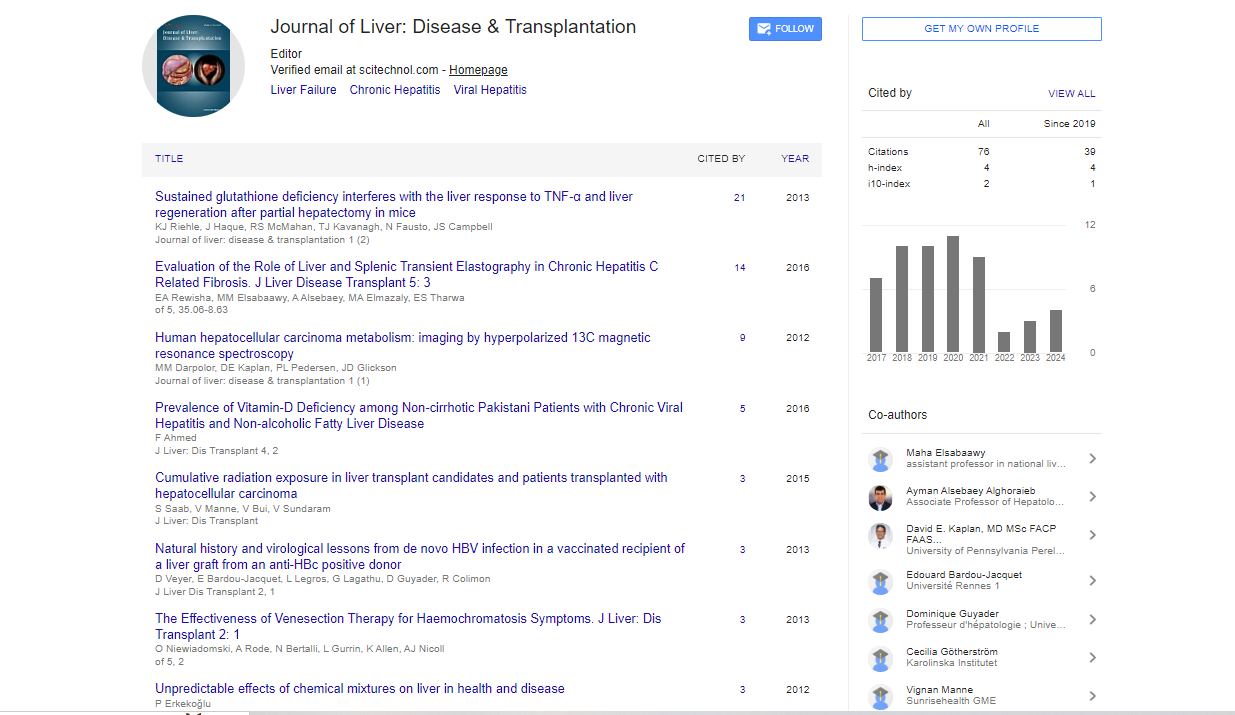Perspective, J Liver Disease Transplant Vol: 13 Issue: 1
A Brief Note on Causes, Symptoms, and Management of Hepatomegaly
Arredondo Routou*
1Department of Radiological Area, E.O. Galliera Hospital, Genova, Italy
*Corresponding Author: Arredondo Routou,
Department of Radiological Area,
E.O. Galliera Hospital, Genova, Italy
E-mail: routou.arre@galliera.it
Received date: 12 February, 2024, Manuscript No. JLDT-24-135116;
Editor assigned date: 14 February, 2024, PreQC No. JLDT-24-135116 (PQ);
Reviewed date: 28 February, 2024, QC No. JLDT-24-135116;
Revised date: 06 March, 2024, Manuscript No. JLDT-24-135116 (R);
Published date: 13 March, 2024, DOI: 10.4172/2325-9612.1000258.
Citation: Routou A (2024) A Brief Note on Causes, Symptoms, and Management of Hepatomegaly. J Liver Disease Transplant 13:1.
Abstract
Description
Hepatomegaly, the medical term for an enlarged liver, is a condition that warrants thorough investigation and understanding due to its diverse etiology and potential complications. As a common clinical finding, hepatomegaly can be indicative of various underlying diseases, ranging from benign conditions to life-threatening illnesses. The etiology of hepatomegaly is broad and encompasses a spectrum of pathological processes. Common causes include viral hepatitis infections (such as hepatitis B and C), alcoholic liver disease, Non- Alcoholic Fatty Liver Disease (NAFLD), cirrhosis, liver cancer (hepatocellular carcinoma), congestive heart failure, infectious diseases (such as mononucleosis and malaria), and autoimmune conditions (such as autoimmune hepatitis). Additionally, metabolic disorders, such as Wilson's disease and hemochromatosis, can contribute to hepatomegaly by disrupting normal liver function and leading to abnormal accumulation of substances within hepatic tissues.
The clinical presentation of hepatomegaly varies depending on the underlying cause and the degree of liver enlargement. While some individuals may remain asymptomatic, others may experience a range of nonspecific symptoms, including abdominal discomfort or pain in the right upper quadrant, fatigue, nausea, and jaundice. In advanced cases, complications such as ascites, hepatic encephalopathy, and coagulopathy may manifest, further complicating the clinical picture and necessitating prompt medical intervention. Accurate diagnosis of hepatomegaly involves a comprehensive evaluation encompassing medical history, physical examination, and diagnostic tests. Laboratory investigations, Including Liver Function Tests (LFTs), serum markers for viral hepatitis, autoimmune serologies, and tests for metabolic disorders, play a pivotal role in elucidating the underlying cause. Imaging modalities such as ultrasound, Computed Tomography (CT), and Magnetic Resonance Imaging (MRI) provide detailed anatomical information regarding liver size, morphology, and presence of focal lesions. In select cases, liver biopsy may be warranted to obtain histological confirmation of the underlying pathology, particularly in instances of suspected malignancy or uncertain diagnosis.
The management of hepatomegaly hinges upon addressing the underlying cause, alleviating symptoms, and preventing complications. Lifestyle modifications, including abstinence from alcohol, weight loss, and dietary changes, are paramount in managing hepatomegaly secondary to conditions such as alcoholic liver disease and NAFLD. Pharmacological interventions may be indicated for specific etiologies, such as antiviral therapy for hepatitis B and C infections, immunosuppressive agents for autoimmune hepatitis, and chelation therapy for metabolic disorders. In cases of advanced liver disease, liver transplantation may be considered as a definitive treatment option, offering the potential for improved survival and quality of life. Upon diagnosis, the focus shifts towards treating the root cause, which could range from liver cirrhosis, hepatitis, to fatty liver disease or liver cancer.
This involves a combination of lifestyle modifications, such as dietary changes and exercise, alongside targeted medical interventions like medications or surgical procedures. Symptomatic relief is also prioritized through pain management and alleviation of associated symptoms like fatigue or jaundice. Regular monitoring of liver function tests and imaging studies helps track the progression of treatment and adjust management accordingly. Moreover, preventive measures such as abstaining from alcohol, maintaining a healthy weight, and managing comorbid conditions play a crucial role in minimizing the risk of complications like liver failure or portal hypertension. Ultimately, a multidisciplinary approach involving specialists like hepatologists and gastroenterologists ensures a tailored management plan aimed at optimizing liver health and overall wellbeing.
Conclusion
In conclusion, hepatomegaly represents a complex clinical entity characterized by diverse etiologies, variable presentations, and significant implications for patient management. A systematic approach to diagnosis, guided by thorough clinical evaluation and appropriate investigative modalities, is essential for accurate identification of the underlying cause and implementation of targeted therapeutic interventions. By elucidating the pathophysiological mechanisms underlying hepatomegaly and delineating evidence-based management strategies, this essay aims to enhance understanding and facilitate optimal care for individuals affected by this condition. Through continued study efforts and clinical advancements, the prognosis for patients with hepatomegaly can be further improved, underscoring the importance of ongoing collaboration between healthcare professionals and researchers in this field.
 Spanish
Spanish  Chinese
Chinese  Russian
Russian  German
German  French
French  Japanese
Japanese  Portuguese
Portuguese  Hindi
Hindi 